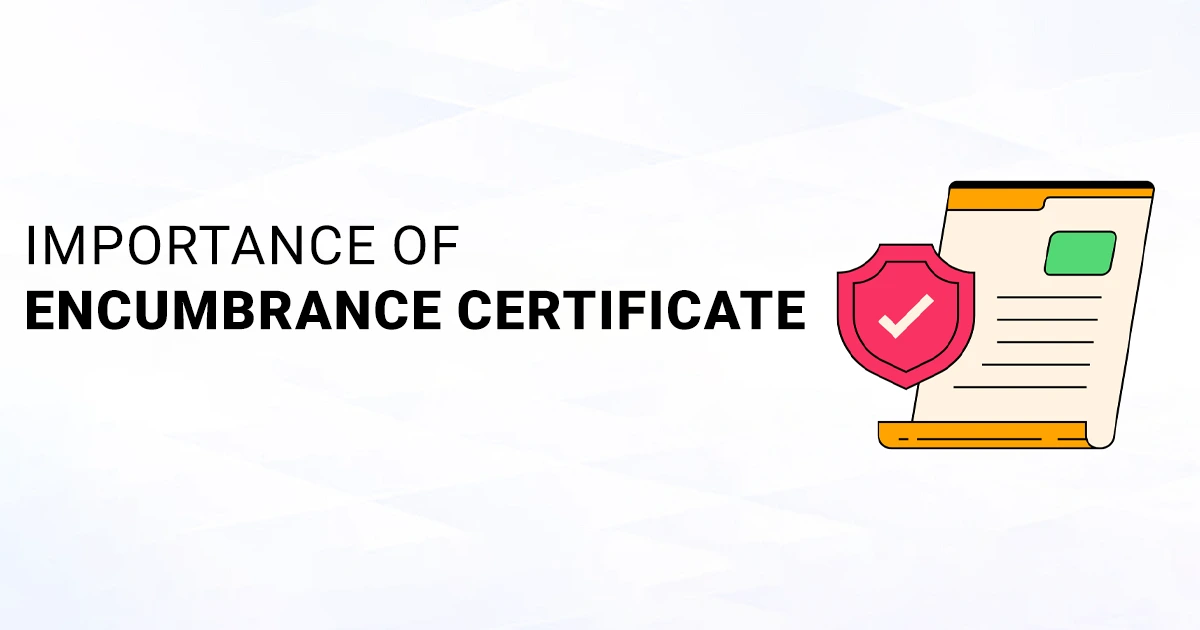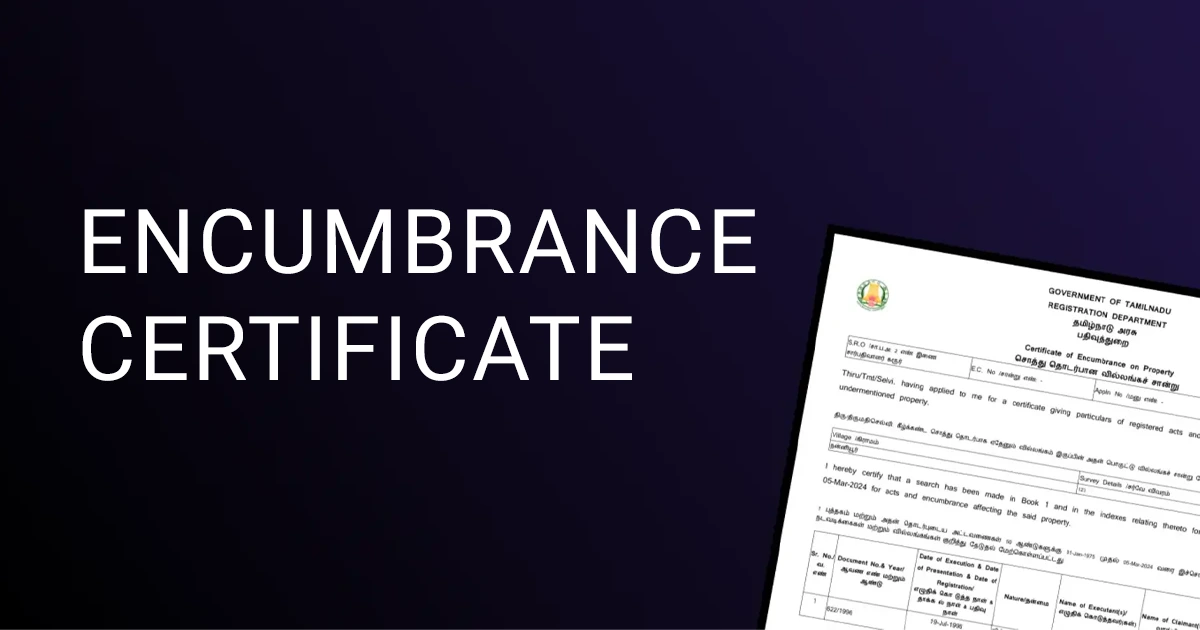Every property has a history, and not every history is pleasant. A pending mortgage. A disputed inheritance. A court injunction about which you remain unaware.
These hidden red flags are not likely to be presented before you in a brochure or ad pitched by a sales representative. Still, they appear obtrusively on an Encumbrance Certificate, the document tracing the property through its commercial and legal history, thus ensuring you do not step into someone else’s unfinished story.
If you have ever wondered, “Where can I get an encumbrance certificate?” or, “How can I apply for EC online?,” this blog is your one-stop guide for the state-wise procedural steps, from format to fees to verification and legal importance.
What is an Encumbrance Certificate?
Encumbrance Certificate, commonly known as EC, is a legal document obtained from the sub-registrar’s office. This can be obtained only for a specific piece of estate against which collateral has been created. It is one of the attested documents that declare that the property is free from any allegations seeking legal redress or otherwise, eg, under charges, mortgages, court injunctions, etc., till the said document date.
The inability to receive clear legal certification and ownership of a property will cloud its marketability value. If any revenue or leasing liability applies, that will appear in the EC form.
Read Also: Property Search Report: Legal Importance and Process
What is The Full Form of EC?
An Encumbrance Certificate is what EC stands for. This particular document is necessary to prove the clear title of the property and is needed when:
- Selling or buying property
- Application for a home loan
- Application for property mutation
- Construction of a house financed by a bank
What is the Importance of Encumbrance Certificate?

In real estate transactions, it is practically impossible to overemphasize the importance of an encumbrance certificate. Here are some reasons one must have it:
- Proof of Clear Ownership: It proves that the property is free from any encumbrance or dispute.
- Loan Approval: Financial institutions would insist on an EC before granting loans against property.
- Fraud Prevention: It helps in detecting any previous fraudulent sale or double registration.
- Legal Requirement: Some states mandate the EC as a condition for registering property transfers or mutations.
- Safety of Investments: EC becomes a crucial tool for investors to ascertain that the property is marketable.
Also Read: Stay Order on Property: Vacate It with Legal Steps
Encumbrance Certificate Format
An encumbrance certificate usually contains the following information:
- Name of the owner(s) of the property
- Property description (i.e. the location, survey number, plot number and so on)
- Transaction details (sale, mortgage, lease, gift or the like)
- For what duration does one need EC
- Signature and seal of issuance authority (i.e. Sub-registrar)
There are mainly two types of ECs
- Form 15: In case of transactions or encumbrances existing during the given period
- Form 16 (Nil EC): If there are no transactions or encumbrances existent
What Documents Needed for Encumbrance Certificate?
The following papers are generally necessary for making an application for an EC:
- Application Form (obtained from the sub-registrar’s office or online portal)
- Property Information (survey number, plot number, etc.)
- Copy of Title Deed/ Sale Deed
- Property Tax Receipts
- Identity Proof (Aadhaar card, PAN card, etc.)
- Address Proof (utility bill, voter ID, etc.)
- Receipt for the payment of fees
- The requirements may vary slightly from state to state.
How to Get an Encumbrance Certificate: Online and Offline Process
Almost all states now offer online EC encumbrance certificate services, making the application process a lot easier. This is how both methods will work:
Here’s how to get an Encumbrance Certificate through the Online method
Most of the state government departments have digitized property records and made provision for online access for encumbrance certificates. Mentioned below is how to apply:
- State Government Registration Department Website
- Example: kaverionline.karnataka.gov.in
- Log in/Register on the Portal
- Navigate to the EC Services Section
- Enter Property Details
- District, SRO, property address, deed number, etc.
- Upload Required Documents
- Pay the Required Fee (varies by state and duration)
- Downloading Acknowledgment Slip
- Obtain EC via Email or download from the portal
Offline Method: How to Get EC at the Sub-Registrar Office
If online facilities aren’t obtained in your area, pursue this offline process:
- Go to the Sub-Registrar Office under which the property is registered.
- Apply with supporting documents.
- Pay the due fee (normally on a duration basis).
- Receive Acknowledgment Receipt
- The certificate is generally issued within 7-15 working days.
Where Can I Get an Encumbrance Certificate?
An EC can be obtained from the following sources:
- The Sub-Registrar’s Office where the property is registered (for offline application).
- The government state portal of the Registration Department (for online application).
Some states also offer Meeseva or e-Seva centers for assisted digital applications.
What is an Encumbrance Certificate in Haryana?
In Haryana, an Encumbrance Certificate may be applied for via both online and offline options. The Jamabandi portal has been set up by the Department of Revenue and Disaster Management, Haryana, for property-related services, including ECs.
Steps to Apply for Online Services in Haryana:
- Go to the jamabandi.nic.in site
- Look for “Property Registration” or “Encumbrance Certificate” service
- Fill in the property information, upload documents
- Pay the service fee online
- Download the certificate or present the SRO at the end after processing.
Although processing time is usually around 10 to 15 days in Haryana.
Also Read: What is a Possession Certificate? Format, Application, and Difference
How Do I Verify My Encumbrance Certificate?
Verifying an EC is key to ensuring that it is authentic. Steps may include:
Online verification:
- Access the registration department website of the respective state
- Use the EC reference number or application ID
- View and download the certified copy
Offline verification:
- Go to the Sub-Registrar Office
- Present the EC copy and request for verification
- Cross verification with official records and transaction entries
In addition, to make certain of the above:
- Official seal and signature of the authority
- Correct period and transaction details
- Unique Document ID or reference number
In Short:
An Encumbrance Certificate is not just a legal paper; it is your insurance against accidents and liabilities hanging over the property in the future. A buyer, a seller, or anyone else inquiring about a home loan will be cent per percent legally secured and standing in an upright position in their property dealings if they possess a valid EC.
Just as everything was going digital for the betterment of the processes, most of the Indian states allowed applicants to apply for an EC encumbrance certificate even without stepping out of their luxury homes. However, the important documentation requirement for an encumbrance certificate, the process of acquiring it, and the format of an encumbrance certificate need to be understood as well for a clear estate transaction.
Whether you search for “where to get an encumbrance certificate” or ask about “what is an encumbrance certificate in Haryana,” you will have the same answer to it: you have to follow a systematic, state-specific process to make sure that all property dealings are safe and legally bound.





Comments are closed